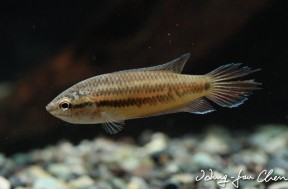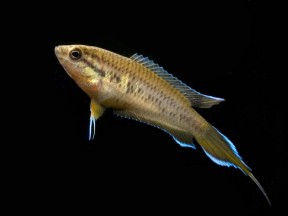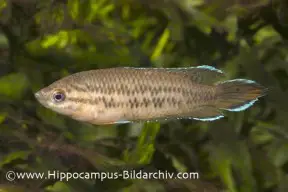Pseudosphromenus dayi
Brown Spike-tailed Paradise Fish
SynonymsTop ↑
Polyacanthus cupanus dayi Köhler, 1908; Macropodus dayi (Köhler, 1908); Macropodus cupanus dayi (Köhler, 1908)
Etymology
Pseudosphromenus: from the Ancient Greek ψευδής (pseudes), meaning ‘false, lying, untrue’, and a misspelling of the generic name Osphronemus.
dayi: named for Francis Day, ichthyologist and former Inspector-General of Fisheries for India and Burma.
Classification
Order: Perciformes Family: Osphronemidae
Distribution
Known only from coastal drainages of the Western Ghats mountains in southern Kerala state, India, specifically the Chalakkudy, Muvattupuzha, and Periyar rivers, although it may be more widely-distributed.
Engmann (1909) gives type locality as ‘Malakka’ but this is considered an error which probably should have read ‘Kerala’.
Habitat
Apparently shows a preference for sluggish and still waters such as rice paddies, swamps and weedy ponds, tending to be most common in floodplains and other lowland areas.
It has also been collected from the margins of rivers and ditches with dense growths of submerged vegetation.
In Kerala species inhabiting similar environments include Carinotetraodon imitator, Laubuca dadiburjori, Aplocheilus parvus and Horadandia atukorali.
Maximum Standard Length
60 – 65 mm.
Aquarium SizeTop ↑
Minimum base dimensions of 60 ∗ 30 cm or equivalent are recommended.
Maintenance
Can be maintained in a fully-decorated aquarium although many breeders prefer not to use a substrate for ease of maintenance.
Driftwood roots and branches can be used and placed such a way that a few shady spots are formed, while half-coconut shells or upturned clay flower pots with entrance holes chipped in the rims represent ideal spawning sites (see ‘Reproduction’).
The addition of dried leaf litter further emphasises the natural feel and as well as offering additional cover brings with it development of microbe colonies which can provide a valuable early food source for fry.
This species prefers fairly dim lighting so the use of surface vegetation, floating or otherwise, is also useful. As it naturally inhabits sluggish waters filtration should not be too strong, with an air-powered sponge unit adequate.
Water Conditions
Temperature: 20 – 28 °C
pH: 6.0 – 7.5
Hardness: 36 – 268 ppm
Diet
Likely to prey on insect larvae and suchlike in nature, and should be offered small live or frozen Daphnia, Artemia, white worm, grindal worm, etc., in captivity.
Dried foods may be examined and even pecked at but are not consumed in sufficient quantities to bring about optimal condition.
Small insects such as crickets or Drosophila fruit flies are also suitable to use; it is best to fill the stomachs of these by feeding them fish flakes or some kind of vegetable matter before offering them to the fish.
Behaviour and CompatibilityTop ↑
This species is peaceful but does not make an ideal community fish due to its small size and rather timid nature.
Some small cyprinids and loaches that inhabit similar environments in nature are compatible, but similar-shaped fishes are best-omitted.
It can be maintained in a pair or group, and will display some interesting behavioural interactions under the latter circumstances.
Sexual Dimorphism
Adult males develop extended dorsal, anal and caudal fins, plus orange pigmentation around the lower head and throat as they mature, whereas females remain less colourful with shorter fins.
Sexually mature individuals can also be sexed by placing a strong light behind the fish, with the ovaries in females clearly visible.
Reproduction
Secretive bubble nester. Males prefer to contruct nests under an overhang or in a cavity if available, although if not surface vegetation, leaves or roots may be chosen.
In the aquarium half-coconut shells, upturned flowerpots or clay pipes provide ideal artificial spawning sites. Eggs and milt are released in small batches during a series of embraces in which the male wraps its body around that of the female.
Some males construct a rudimentary bubble nest while others do not, but either way both male and female attempt to attach the eggs to the ceiling of the site after they are released.
Post-spawning the female is normally ejected and the male solely responsible for guarding and tending the eggs.
Incubation is approximately 24-48 hours with the fry free-swimming after 2-3 additional days after which they are able to accept Artemia nauplii, microworm, etc.
Once the fry are swimming freely they may be consumed by other fish in the aquarium, including their parents, so are best separated and grown on elsewhere.
NotesTop ↑
This species is most easily told apart from its only congener P. cupanus by possessing (vs. lacking) two dark, irregular lateral stripes on the head and body, and a more extended caudal-fin in males.
The results of phylogenetic analyses by Rüber et al. (2006) suggest that Pseudosphromenus is most closely-related to Malpulutta in an evolutionary sense. Both are sometimes included in the putative subfamily Macropodusinae alongside the genera Macropodus, Parosphromenus, Betta and Trichopsis.
Like others in the suborder Anabantoidei this species possesses an accessory breathing organ known as the labyrinth, which permits the fish to breathe atmospheric air to a certain extent. Comprising paired suprabranchial organs formed via expansion of the epibranchial (upper) section of the first gill arch and housed in a chamber above the gills, it contains many highly-vascularised, folded flaps of skin which function as a large respiratory surface. Its structure varies in complexity between species, tending to be more developed in those inhabiting harsher environments. While some labyrinth fishes can be observed taking regular gulps of air from the surface others, including Pseudosphromenus spp., do so less often.
References
- Engmann, P., 1909 - Stuttgart v. 20: 473-476
Polyacanthus cupanus var. Blätter für Aquarien- und Terrarien-Kunde. - Beevi, K. S. J and A. Ramachandran, 2009 - Journal of Threatened Taxa 1(9): 493-494
Checklist of freshwater fishes collected from Ernakulam District, Kerala, India. - Kottelat, M., 1994 - Journal of South Asian Natural History 1(1): 31-33
Authorship and date of publication of Pseudosphronemus dayi (Pisces: Belontiidae). - Kullander, S. O., M. M. Rahman, M. Norén and A. R. Mollah , 2015 - Zootaxa 3990(4): 575-582
Why is Pseudosphromenus cupanus (Teleostei: Osphronemidae) reported from Bangladesh, Indonesia, Malaysia, Myanmar, and Pakistan? - Köhler, W., 1908 - Blätter für Aquarien- und Terrarien-Kunde. Stuttgart. v. 19: 392-396
Untersuchungen über das Schaumnest und den Schaumnestbau der Osphromeniden. - Linke, H., 1992 - Tetra Press: 176 pp.
Labyrinth Fish: The Bubble Nest Builders. - Rüber, L., R. Britz, R., and R. Zardoya, 2006 - Systematic Biology 55(3): 374-397
Molecular phylogenetics and evolutionary diversification of labyrinth fishes (Perciformes: Anabantoidei).





